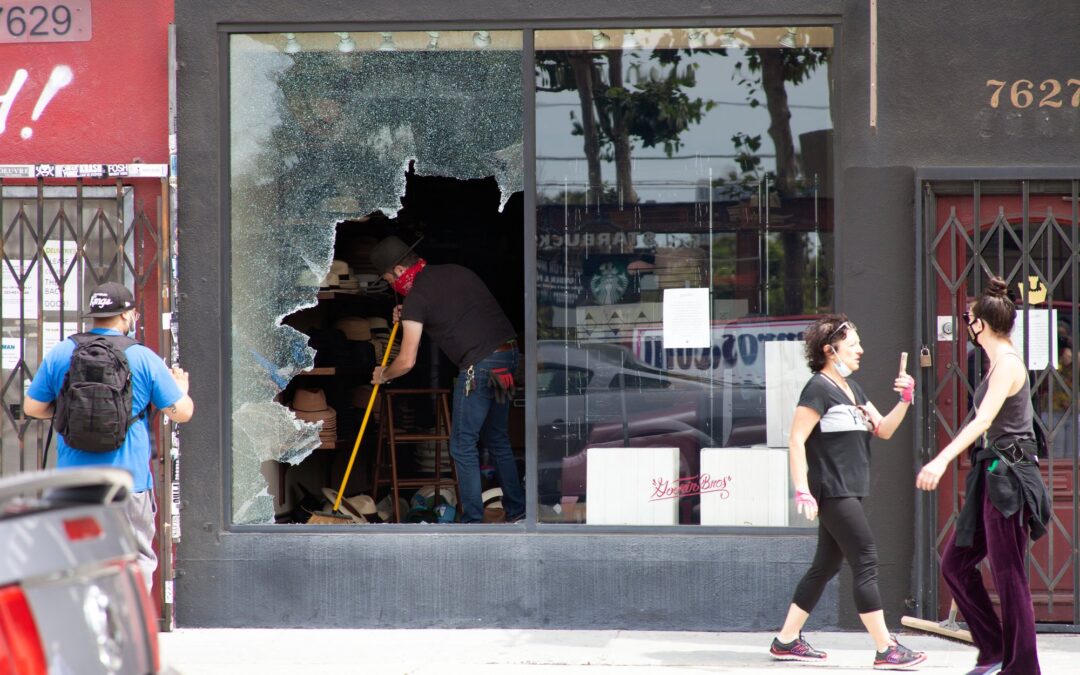It is no secret that in recent years several cities have experienced a rise in the incidents of civil unrest in the form of sporadic violence, vandalism, looting and arson that has shut down businesses and has reportedly caused billions in damages. Civil unrest is a broad term typically used by law enforcement to describe disruptive situations like a riot, protest, or strike, caused by a group of people. These gatherings are often fueled by disagreements around politics; racial, gender or income inequality; discrimination; or health care issues. While many of these gatherings begin peacefully, they can quickly turn violent and, as witnessed on the nightly news, can lead to arrests, injuries, and destruction of the community and nearby businesses. There are three levels of civil unrest:
- The lowest level of civil unrest Is when people turn on their own neighborhoods. This type of civil unrest is spontaneous and localized, primarily impacting those who live, work, or travel in the immediate area.
- The next level of unrest is focused on a single area where protesters deliberately target a business district, facility, transportation system, or an organization to impose maximum disruption.
- The final level of civil unrest causes a disruption at a regional level, affecting everyone in the region. This can also expand to a national or even international level.
While understanding that the tactical security game plans prepared in response will be unique to every organization due to factors such as different threat landscapes, locations, size, culture, etc., there are actions all organizations can take to protect employees, sites, and assets during times of civil unrest. A security expert from National Protective Services, Inc. can help you develop a cost-effective security plan that takes these new threats into account and saves you money.
Employees can practice one important behavior that might make a significant difference in keeping themselves, their colleagues, and their organizations safe-and that is situational awareness. Simply put, that means being vigilant and increasing awareness of one’s surroundings: Pay attention to your surroundings, make observations, and draw appropriate conclusions. Learn to key in on the unusual or on someone or something that seems out of place. Here are some safety practices to keep in mind:
- Avoid protest areas or large gatherings, if possible.
- Stay calm.
- Maintain a low profile.
- Actions that enhance your personal safety and security should be your main concern.
- Remove all articles from your person which display wealth, to include rings, watches, jewelry, etc.
- Identify the location of emergency exits and exit paths from the area which has posed the most risk to your safety.
- Remember the five-step process for an active shooter type situation: awareness, assess the situation, consider your options (run, hide, fight) and the risks, take an action.
- Quickly and safely remove yourself from the area where an incident may/is/has occurred.
- If you cannot safely remove yourself, seek shelter.
- Once your safety is secured, contact authorities.
- Comply with the command of authorities.
- Do not in any way appear or engage in a threatening manner to authorities.
- Avoid targeted areas of civil unrest, protest, or riot.
- Anticipate cell phone/landline disruption.
- Monitor local media and/or trusted sources for updates.
- Follow your company’s communication plan and/or evacuation procedures.
- Consider establishing a communication plan for family members.
The results of civil unrest have taken its toll on businesses. There are things businesses can keep in mind to help protect themselves and their employees.
- Put Business Contingency Plans in place and ensure these plans are updated and tested routinely.
- Have Security Staff in place. Ensure security officers are aware of policies and procedures in place in response to protests and riots.
- Site Security-Conduct a review of current security game plans, including gate and breach management procedures, to ensure all are appropriate for given circumstances. Enhance security infrastructure when warranted.
- Install surveillance cameras.
- Technical Operations, make sure security infrastructure hardware and software components are functioning properly and camera monitoring processes are in place to ensure complete coverage.
- Threat Management. Ensure all security staff have a heightened sense of awareness on threat management and are routinely retrained on any procedures and protocols in place to address potential threats.
- Have a Workplace Safety/Active Shooter Plan in place. Provide appropriate training and retraining on their options and risks in an active shooter situation.
- Communication is key! Ensure communication plans with and between employees, security and other staff is tested and functional. Convey any intelligence received to staff members. Also ensure employees know to communicate their status to those in charge.
For further reading check out Civil Unrest and Employees: When Community Concerns Become Workplace Challenges.
National Protective Services is here to help you.
National Protective Services, Inc. is a women and minority owned private security firm with more than 40 years’ experience serving Virginia and Maryland. We specialize in both physical and electronic security. Our mission is to provide unparalleled customer care, and to provide an effective, personalized security service. We don’t just serve clients; we forge relationships that last for years. This is why many NPS clients have remained with us for more than a decade. We offer a range of services, tailored to fit the needs of each client individually. Contact us today at 1-800-382-2703 to schedule a short, free, no obligation consultation. We can work together to come up with a security plan designed to meet your individual needs. See how it feels to be protected like family.

